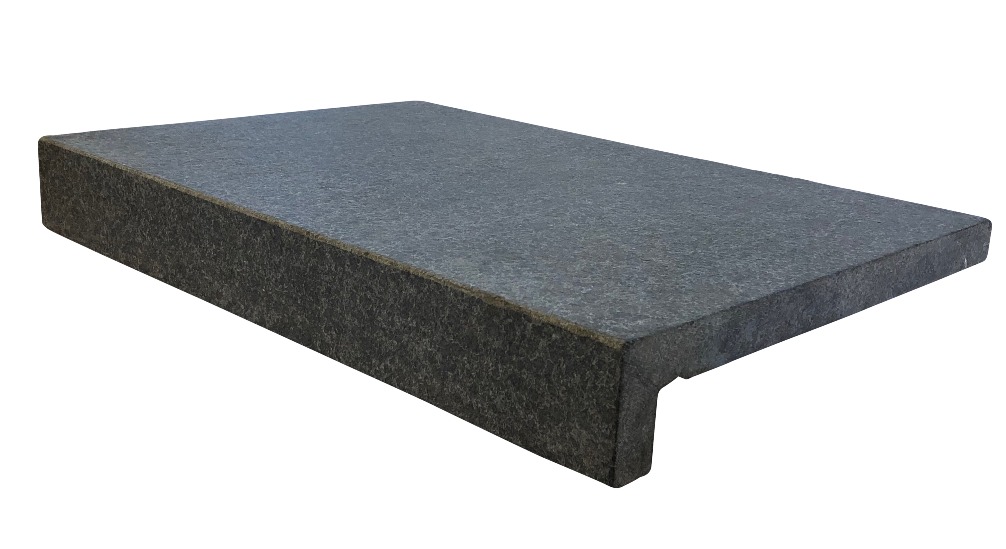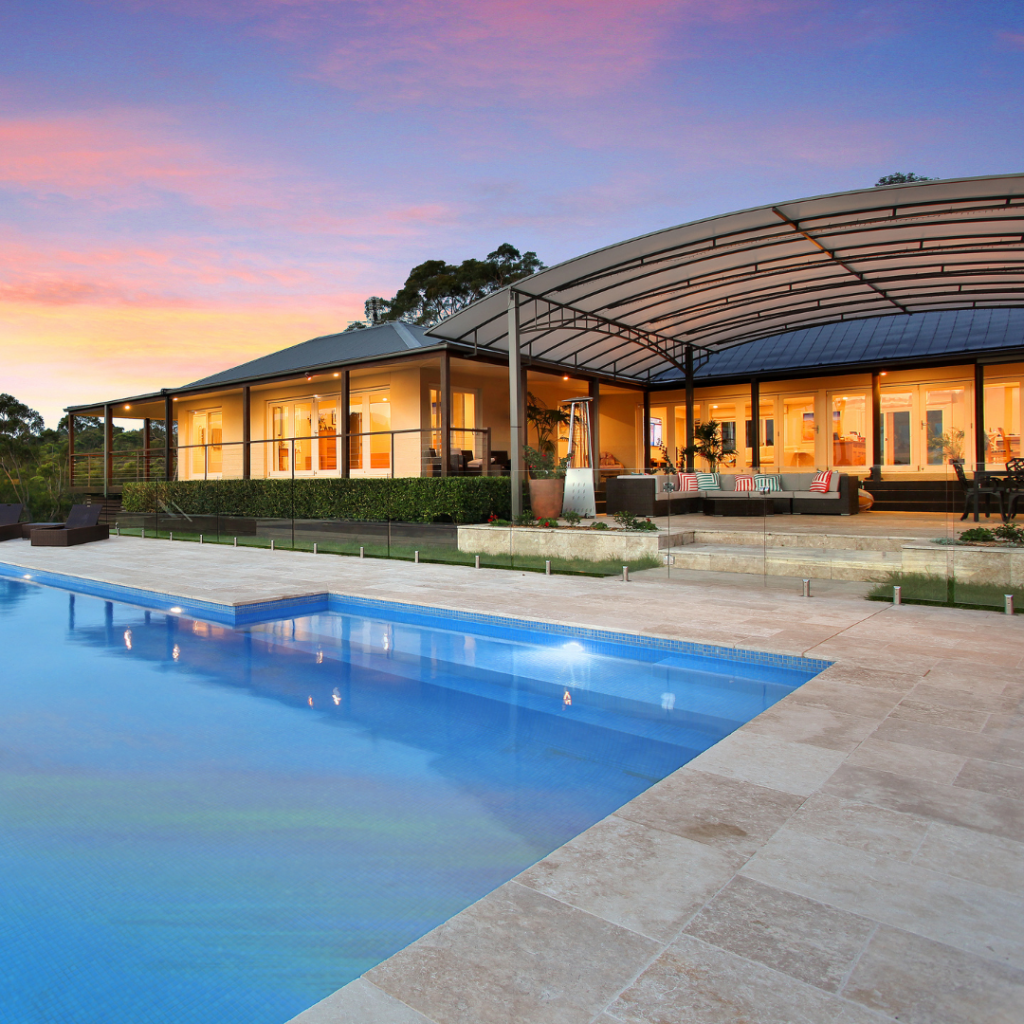The Best Time to Get Your Pool Project Underway
“Ensure that you allow enough time for the entire consultation, design, construction, and finishing process. The individual timeline of each project varies and because delays can come up, the planning is crucial,” says Gary.
Gary’s experience says that you should select the stone at least 14 weeks before you think you need it.
“Don’t leave the stone selection to the last minute. Consider the transit time, as you need to allow 14-16 weeks for shipping if your selected products aren’t in stock.
And you can’t avoid the lead times if you have special requests like dropdown edges or custom sizes”.
What Are the Stages of the Pool Building Process?
According to Crystal Pools, 3 to 6 months is the expected timeline of the pool building process, which consists of three main stages:
- Pre-construction (includes planning, site assessment, design, engineering, and proposal)
- Council Approval
- Pool construction and finishes (including landscaping)
This is a rough guide since the time of each stage varies significantly. The excavation process depends on the subbase material and difficulty, including access to the site. Things can be further held up at the council if you’re waiting for approval and cannot progress to the next stage.
While tiling the pool surrounds can be done in a few days, additional landscaping and other features take more time.

Before You Start Planning…
Gary points out that the crucial fact of the process is that one trade heavily depends on the other.
“For example, from the time the pool is concreted, the shell needs to cure for at least 1 month before you can tile it with natural stone and glass mosaics.”
Other ways in which the trades have an impact on each other’s timeline include:
- if a fence is to be placed on top of the pool surrounds, the stone needs to be laid first;
- you can’t fill the pool with water before fencing is done;
- there are restrictions on the use of power tools once the pool is filled with water, etc;
What’s the Best Surface Finish for Natural Stone Around Pools?
Since the surface areas around pools are expected to get wet, selecting a surface finish with a suitable slip rating is important. Slip rating is a scale used to assess the frictional characteristics of the surface in different environmental conditions.
Currently, there is no Australian standard for required slip rating around residential pools. The exception is for external stairs, which are required to have a P4 slip rating.
At Sareen Stone, we offer various outdoor finishes – tumbled or alfresco, including sandblasted and flamed finishes.
“All of our alfresco finishes meet a minimum P4 rating slip rating,” Gary explains. “Our Tumbled Travertine is a P3 slip rating and is attractive if you’re looking for a smooth and soft feel underfoot. On the opposite end of the spectrum, our flamed finish is the most textured.”
Other Official Regulations to Consider?
Other regulations to keep in mind include:
- Every new pool in NSW must be approved for construction by a Licensed Certifier. Some pools require a Development Application (DA) approval from the council, while some can be processed quicker as Complying Development
- Fencing regulations and proximity of climbable objects
Always refer to the Licensed Pool Builder or other experts/engineers to find out all the official regulations that impact your pool building process.

Natural Stone vs Porcelain for Pools?
With a growing outdoor porcelain range of tiles that provide a highly non-grip finish and a textured feel, porcelain tiles are being used around pools more frequently. People opt for porcelain tiles because of their low maintenance and fewer surface variations.
Gary considers selecting Sandstone lookalike porcelain tiles as a good alternative because of their higher resistance to the harsh environment around pools than natural Sandstone. Other than that, he thinks that natural stone is the best candidate for the job.
Alongside fewer surface variations of porcelain tiles, you also lose the natural diversity in a pattern that is unique to stone, says Gary. “Natural stone just has a different feel, it connects to the Earth, and gives you a sense of exclusivity and timeless beauty. And also increases the value of your home.”
How Much Does a Pool Cost?
Clients’ range on their pool varies from $35,000 to well over $100,000. According to Crystal Pools, the average spent on a pool in Sydney is currently around $45,000 to $55,000.
The main components of the pool building project that determine the price include:
- Size of the pool
- Quality of the finishes (type of natural stone, its thickness, etc.)
- Pool coping
- Glass mosaics
- Fencing
- Heating and cleaning technology
What Is Pool Coping?
Pool coping is used around the edge of swimming pools. If you are in the water and holding the side of the pool you will be holding on to the coping. Likewise, if you are dangling your feet in the water chances are you are sitting on the pool coping.
- The coping assists in reducing the amount of water that splashes from the pool
- Pool coping covers and protects the bond beam that makes up the pool shell, maintaining the integrity of the pool’s structure
- Aesthetically, coping connects the pool to the surrounding alfresco area
- To improve comfort and safety, the Bullnose and Pencil edge pool coping shape the square edges into smoother round profiles

What Is the Best Coping For Pools?
Gary explains that the choice of pool coping depends on the clients’ preferences since each type of pool coping comes with its own appeal.
The Pencil Edge finish looks square from the front but has a rounded edge on the top and bottom of the stone.
The rounding has only a small diameter like a pencil that suits contemporary designs.

The Bullnose Edge is fully rounded on the edge of the stone, making it suitable for a more traditional or heritage pool design.
This edge has the best levels of comfort.

The Drop Edge is a solid piece of stone with a thicker visible drop edge than the rest of the stone.
For example, a 30mm piece of stone can have a 70mm drop edge at the front. This can give the impression that the stone in the project is thicker than it is and is often used for fibreglass pools to cover the edge.

“Most of our products can be manufactured at the factory as one L-shaped piece of stone without a joint, others can be fabricated locally by joining two pieces of stone together to create a drop edge.”
Tiling Your Pool With Glass Mosaics
Glass mosaics offer a variety of colours and are suitable for both waterlines and fully tiled pools. The waterline tiles are set directly under the pool coping and provide the benefits of easy cleaning as well as avoid the formation of the bath-ring effect.
“The width varies between 200mm and 300mm, allowing for the variation of the waterline.”
Gary explains that if your budget allows a fully-tiled pool, it can provide further benefits:
- They are highly durable and able to withstand being exposed to sun, wet and dry cycles
- Protect the longevity of the pool
- Allows you to use fewer chemicals, also reducing the cost of your pool maintenance over time
- Make the pool look more attractive
- Increase the resale value of your property
Common Mistakes People Make When Building Their Pool
1. Selecting stone not suitable for the environment
As I mentioned, it is crucial to consider the slip rating of your selected natural stone tiles. Installing P2 tiles just because you think they look good will be slippery and dangerous for everyone who uses it.
2. Saving money on installation
“There are many other areas that can help you reduce the price of your pool. But saving money on installation shouldn’t be one of them.
Because stone is a porous material, it needs to be expertly installed by a professional. This way, you can easily avoid efflorescence and the need to redo the job later.
Selecting a quality pool builder and installer will save you money in the long run.
3. Not sealing the stone
Sealing the stone with a high-quality sealer specifically developed to protect the natural stone, is the best way to keep the moisture out and prevent mould, mildew, calcium deposits, saltwater damage, or other surface deteriorations.

Popular Natural Stones Used Around Pools
Classic Travertine remains one of the most popular choices when selecting natural stone for pools. Travertine attracts with its versatility of design, good price, and classic look.
Limestones with their alfresco finishes are catching up and are attractive for people looking for a more contemporary design and solid colours with little variation.
7 Pool Design Trends
- The rising popularity of grey colours for the stone used around pools
- Dropdown edges are a new pool-coping design
- The range of porcelain suitable for pools is more varied and popular
- Larger range and better quality of glass mosaics for pools
- While beige is still the leading colour of choice, natural stone in greys is emerging in popularity
- Kidney-shaped pools and unique designs were once the fashion, but most pools now tend to be a classic rectangle shape.
- Alfresco Living means people are investing in landscaping, making the pool centrepiece of the outdoor area.
The idea that the alfresco area links to the indoors is a trend that has become prominent over the last few years. Now, people and landscape designers make a real effort to make the outdoor space feel like an extension of the interiors. They make the connecting with the use of same materials and similar design briefs.
About Gary
Gary Bazzana has been in the natural stone industry for over 20 years and with Sareen Stone since 2009. He specialises in pool, landscaping, and outdoor projects and some of his long-term clients include Crystal Pools, Pool Form Constructions, Freedom Pools, Premier Pools, Jay Pools, and many others.
In his spare time, Gary enjoys walking his loyal friend Rebel, a Labrador/Border Collie cross, cooking up a storm in the kitchen at home, fishing, and watching his son play baseball across the state and recently on TV at sports fields in the USA, where his son recently moved to pursue his dreams.
If you need advice on any outdoor project and want to speak to Gary, you can contact him for his advice and expertise on gary@sareenstone.com.au or by calling 0433 532 183.

